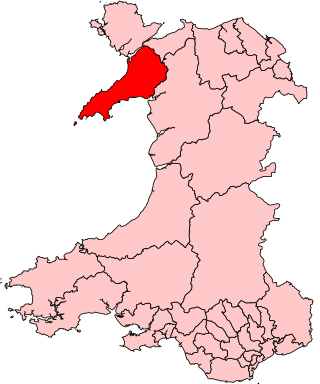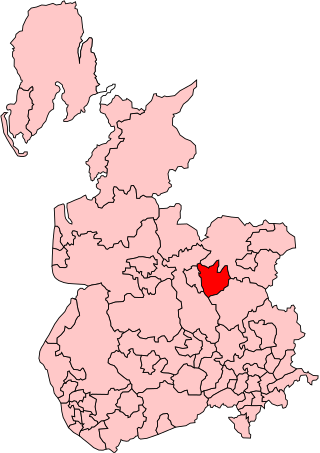
Denbighshire is a county in the north-east of Wales. It borders the Irish Sea to the north, Flintshire to the east, Wrexham to the southeast, Powys to the south, and Gwynedd and Conwy to the west. Rhyl is the largest town, and Ruthin is the administrative centre. Its borders differ from the historic county of the same name.

Historic Denbighshire is one of thirteen traditional counties in Wales, a vice-county and a former administrative county, which covers an area in north east Wales. It is a maritime county, bounded to the north by the Irish Sea, to the east by Flintshire, Cheshire and Shropshire, to the south by Montgomeryshire and Merionethshire, and to the west by Caernarfonshire.

Caernarfon was a parliamentary constituency centred on the town of Caernarfon in Wales. It elected one Member of Parliament (MP) by the first past the post system.

Wrexham is a parliamentary constituency centred on the city of Wrexham in the preserved county of Clwyd, Wales in the United Kingdom. It was created in 1918, and is represented in the House of Commons of the UK Parliament from December 2019 by Sarah Atherton of the Conservative Party.

Accrington was a parliamentary constituency of the House of Commons of the Parliament of the United Kingdom from 1885 to 1983. It elected one Member of Parliament (MP) by the first-past-the-post system of election.

Abingdon was a parliamentary constituency in England, represented in the House of Commons of the Parliament of England until 1707, then of the Parliament of Great Britain from 1707 to 1800 and of the Parliament of the United Kingdom from 1801 to 1885. It elected one Member of Parliament (MP) from 1558 until 1983.
Pembroke was a parliamentary constituency centred on the town of Pembroke in West Wales. It returned one Member of Parliament (MP) to the House of Commons of the Parliament of the United Kingdom, elected by the first past the post system.
Cardiff was a parliamentary constituency centred on the town of Cardiff in South Wales which returned one Member of Parliament to the House of Commons from 1542 until it was abolished for the 1918 general election.

Chester-le-Street was a county constituency centred on the town of Chester-le-Street in County Durham. It returned one Member of Parliament (MP) to the House of Commons of the Parliament of the United Kingdom from 1885 to 1983.
Brentford and Chiswick was a constituency 1918 – 1974 centred on the Brentford and Chiswick districts of Middlesex which became parts of west London in 1965. It returned one member (MP) to the House of Commons of the UK Parliament.
Denbigh was a county constituency centred on the town of Denbigh in North Wales. It returned one Member of Parliament (MP) to the House of Commons of the Parliament of the United Kingdom, elected by the first-past-the-post voting system.
Merioneth, sometimes called Merionethshire, was a constituency in North Wales established in 1542, which returned one Member of Parliament (MP) to the House of Commons of the English Parliament, and later to the Parliament of Great Britain and of the United Kingdom. It was abolished for the 1983 general election, when it was largely replaced by the new constituency of Meirionnydd Nant Conwy.
Monmouth Boroughs was a parliamentary constituency consisting of several towns in Monmouthshire. It returned one Member of Parliament (MP) to the House of Commons of the Parliaments of England, Great Britain, and finally the United Kingdom; until 1832 the constituency was known simply as Monmouth, though it included other "contributory boroughs".
South East Durham was a county constituency represented in the House of Commons of the Parliament of the United Kingdom. It elected one Member of Parliament (MP) by the first past the post system of election between 1885 and 1918.
Newcastle-upon-Tyne was a parliamentary borough in the county of Northumberland of the House of Commons of England from 1283 to 1706, then of the House of Commons of Great Britain from 1707 to 1800 and of the House of Commons of the United Kingdom from 1801 to 1918. It returned two Members of Parliament (MPs), elected by the bloc vote system.
Portsmouth was a borough constituency based upon the borough of Portsmouth in Hampshire. It returned two members of parliament (MPs) to the House of Commons of the Parliament of the United Kingdom, elected by the bloc vote system.
Liskeard was a parliamentary borough in Cornwall, which elected two Members of Parliament (MPs) to the House of Commons from 1295 until 1832, and then one member from 1832 until 1885. The constituency was abolished by the Redistribution of Seats Act 1885.
Stamford was a constituency in the county of Lincolnshire of the House of Commons for the Parliament of England to 1706 then of the Parliament of Great Britain from 1707 to 1800 and of the Parliament of the United Kingdom from 1801 to 1918. It was represented by two Members of Parliament until 1868 when this was reduced to one.
Flint Boroughs was a parliamentary constituency in north-east Wales which returned one Member of Parliament (MP) to the House of Commons of the Parliament of the United Kingdom and its predecessors, from 1542 until it was abolished for the 1918 general election.
Brecon was a parliamentary constituency in Wales which returned one Member of Parliament (MP) to the House of Commons of the Parliament of the United Kingdom and its predecessors, from 1542 until it was abolished for the 1885 general election.









